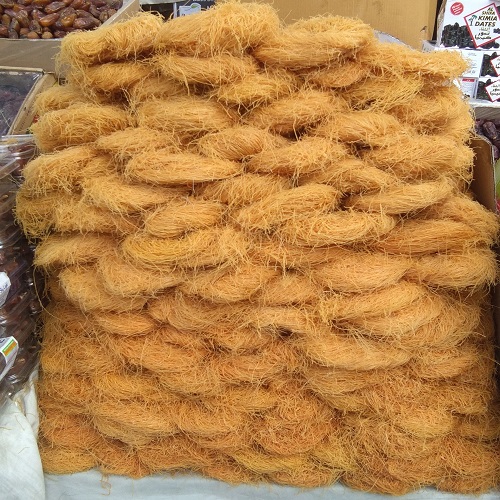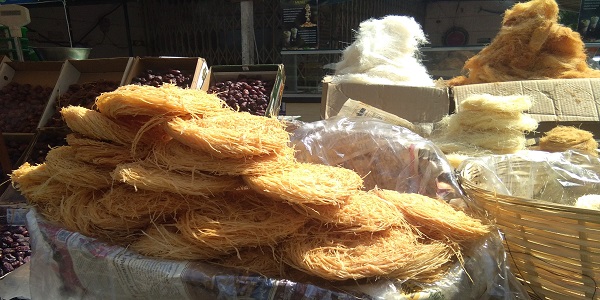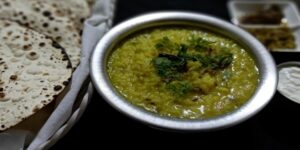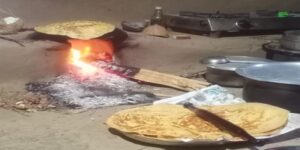Sevai – The soul of Eid Celebration, is especially famous for making sweet dishes. It is used to make fast food, snacks, sweets etc. It is composed of semolina, ragi, wheat, and rice. It is also known as seviyan or vermicelli, a type of thin, spaghetti-like noodle made from wheat or rice flour. It is commonly used in Indian, Pakistani, and Bangladeshi cuisine to make a sweet or savoury dish called Sevai or seviyan. Sevai is an extremely versatile ingredient that can be used in a variety of dishes, from breakfast to dessert.
At weddings, Eid, and other festive occasions and celebrations, Sevai is frequently offered. It can be enjoyed hot or cold and is a popular dish in many parts of South Asia.
Other regional names for Sevai
- In Hindi - It is known as Sevai or Seviyan
- In Kannada - it is known as Shavige
- In Tamil - It is known as Saemia or Santhakai
Origin of Sevai
While the Idiyappam comes from Kerala, the Sevai was first made in Tamil Nadu. While both dishes are traditional South Indian fare, Sevai is made using rice, while Idiyappam is made with rice flour. Idiyappam was traditionally made fresh in Keralan homes and served with coconut milk and sugar.
History of Sevai
K. T. Achaya was a renowned food historian who extensively studied the history and evolution of Indian cuisine. It is important to note that Sevai and Idiyappam references can be found in this ancient book dating back to the first century AD, which is part of the Sangam literature, a collection of Tamil literature from ancient southern India. Both the classic rice-based cuisines from South India, Sevai and idiyappam, are still well-liked today. The process for making Sevai and the used mould press is mentioned in Lokopakara’s (1025 CE) cookbook.
Seviyan is the most important sweet dish at Eid. In celebration of Eid, it is thought that Emperor Shah Jahan requested a special, sunset-coloured varq to accompany their sacrifice of seviyan. It was a tradition that lasted until the time of Bahadur Shah Zafar, who is said to have made his seviyan by hand while fasting using soft wheat dough.

Are Seviyan and Vermicelli the same?
The names for vermicelli are sevai, semai, or semiya, seviyan, and shevaya. It resembles spaghetti in appearance, but it is much thinner and breaks into smaller pieces, and it is roasted (a golden brown colour). In India, it is very easily accessible in any grocery store.
Preparation of Sevai
Sevai is often produced from scratch, beginning with rice grains. Moreover, dried rice sticks known as “Sevai packs” are manufactured by Asian grocery stores. The following are the processes for making Sevai historically, with a few minor adjustments depending on where you are and the customs of your family:
- Three hours of soaking parboiled rice in cold water.
- Utilizing a wet grinder creates a fine paste from soaking rice.
- Using rice paste as the filling and boiling the chunks to make dumplings.
- Produced fine strands of cooked dumplings using a certain sort of Sevai press.

Popular vermicelli dishes
Sweet dish
Another popular sweet dish made with Seviyan is kheer. It is a traditional Indian dessert made with vermicelli noodles, milk, sugar, and cardamom. The vermicelli noodles are cooked in milk until they are soft and creamy. Then sweetened with sugar and flavoured with cardamom. It is usually served cold and garnished with chopped nuts and raisins.
Other Sweet dishes made with sevai
- Kheer
- Sheer Khurma
- Kemami sevai
- Payasam
- Sukhi sevai or Meethi sevai
- Fenni
- Pudding
Savoury dish
One of the most popular uses of Sevai in Indian cuisine is in the preparation of a dish called vermicelli upma. It is a savoury dish made with roasted vermicelli noodles, onions, green chillies, and vegetables such as peas, carrots, and potatoes. The dish is flavoured with spices like cumin, mustard seeds, and curry leaves, and is usually served with coconut chutney or tomato ketchup.
Is vermicelli a healthy weight-loss option?
In terms of nutrition, vermicelli is relatively low in calories and fat but high in carbohydrates, with one cup of cooked vermicelli providing around 200 calories, less than 1 gram of fat, and 45 grams of carbohydrates. It is also gluten-free and a good source of B vitamins and iron.
Sevai is junk food...
It is not junk food because it contains carbohydrates and calories but is still nutritional. Iron, selenium, phosphorus, magnesium, manganese, and zinc are all abundant in them, as well as B-complex vitamins.
Benefits of Semai | Seviyan
- Including Semai with vegetables is an excellent way to include a high-protein food in your diet.
- Wheat Semai is rich in iron and helps in the maintenance of blood haemoglobin levels.
- It is helpful for heart health because it contains zero cholesterol and low sodium, and prevents the risk of heart disease.
- It is a protein-rich food. Each serving contains roughly 9g of protein.
- It is iron-rich food and also prevents anaemia.
- High dietary fibre helps to clean your digestive tract and will help to enhance your overall health.
We are grateful to Ms Khan Shadma Malik for her insightful article on Sevai on the auspicious occasion of Eid. Keep reading our blogs to get more insight into the journey of Indian Food History.




Wow. Got to know so much about Saiyan. An absolutely tasty sweet dish.
Great Work Shadma Khan. Very detailed info.